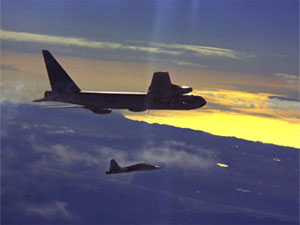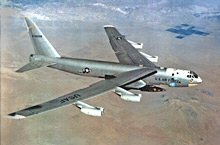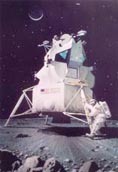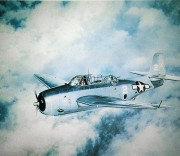|
AVIATION & SPACE HISTORY
NASA's B-52B "008" Retires
Gray Creech
NASA Dryden Flight Research Center
Courtesy NASA
With a penchant for chasing tomorrow, NASA's B-52B "008" always carried the future of flight under its wing.
First taking to the air in June of 1955, the venerable aircraft began its illustrious, nearly 50-year U.S. Air Force and NASA career as a bomb navigation system test airplane for the Air Force's B-52 fleet. Ironically, the bomb/nav system test bomber spent its career dropping flight research vehicles rather than bombs.
Image: Always chasing tomorrow, NASA 008 began an early morning lifting body mission in 1972. NASA photo.
In 1959 it became one of two mothership launch aircraft for the X-15 program, which paved the way for America's early manned spaceflight efforts. Double-0-eight cut its teeth launching a majority of the 199 X-15 flights.
The B-52B's first and last missions launched hypersonic research vehicles, the first being launch of the number one X-15 in 1960. Beginning with the X-15 program, which matured reaction control systems and thermal protection systems for spacecraft, and ending with the X-43A project, NASA 008 served hypersonics research well.
"I was here in Jan. 1960 for the aircraft's first X-15 flight and in Nov. 2004 for the last X-43A flight, and for all of the flights in-between," said Roy Bryant, NASA Dryden's B-52B project manager of nearly 30 years. "Pride, dedication and innovation have been the key elements of the people who maintained this vintage aircraft to support the many projects that have kept the United States at the forefront of aerospace development for the past 45 years," Bryant said.
Since the end of the X-15 program in 1969, NASA 008 has supported virtually all of NASA's aeronautical research programs requiring air launch, and some research missions that didn't.
The Space Shuttle owes several design characteristics and later refinements to NASA 008.
Starting in the mid-1960s, NASA 008 carried aloft several types of lifting body aircraft over a 10-year period. These wingless wonders demonstrated controlled flight without wings and precision landing without power that proved the viability of gliding Space Shuttle landings. With the arrival of the Shuttle era, NASA 008 dropped Shuttle solid rocket booster test vehicles in order to test the booster recovery parachute system. During the early 1990s, the aircraft kicked up plumes of dust on Rogers Dry Lake wringing out the Shuttle's new drag chute system.
One of the more memorable missions for Bryant was a day in 1978 that one of the Shuttle solid rocket booster test vehicles didn't drop on command. B-52 launch panel operator Ray Young reported that his lights indicated the hooks holding the vehicle had opened, even though the vehicle remained attached to the pylon. Pilot Fitz Fulton tried maneuvering the aircraft to free the stuck vehicle, but to no avail. "There was a lot of concern that we'd damage the B-52 if it came loose on landing," Bryant remembers. Fulton greased the B-52 in for a really smooth landing, and the test vehicle held on.
Over the years the aircraft launched various experimental fixtures, such as the FB-111 crew capsule, and advanced remotely-piloted vehicles like the F-15 Spin Research Vehicle, both for the Air Force.
Maintenance crews over the years grew fond of the aircraft, treating it more like a classic car than an old bomber. Double-0-eight's crews kept it in ship-shape, seldom failing to have the aircraft ready for a mission. Not that the old bird didn't balk at the prospect occasionally. 
B-52 carrying the X-15. U.S. Air Force photo
Always reliable, NASA 008's long career ended as historically as it began, launching the last hypersonic X-43A scramjet powered research vehicle on Nov. 16, 2004, to nearly Mach 10, a record speed for airbreathing aircraft.
A hieroglyphic-like silhouette representing the last research mission, recently painted on by crew member Monty Hodges, joined many on the aircraft's starboard fuselage, a virtual museum wall documenting every mission of the aircraft's flight through history.
As NASA 008 flies into the sunset, its legacy continues to soar into the future. Thanks for the ride, 008.
Back to top.
|






